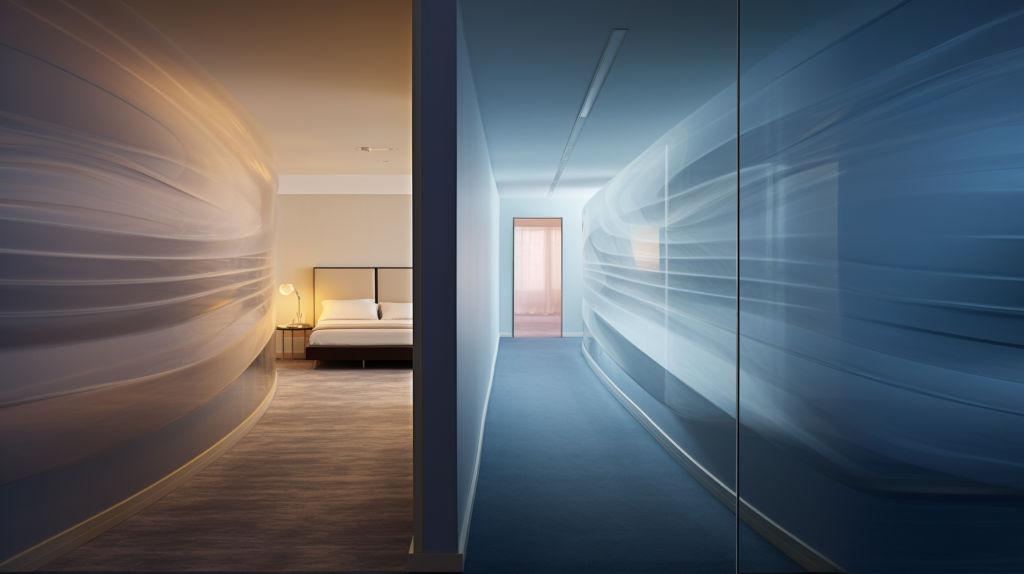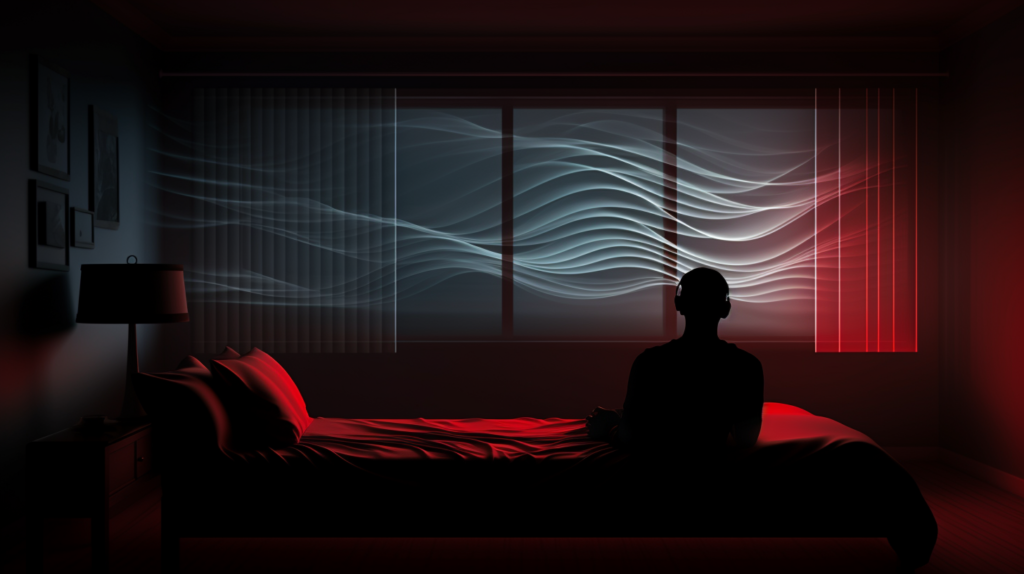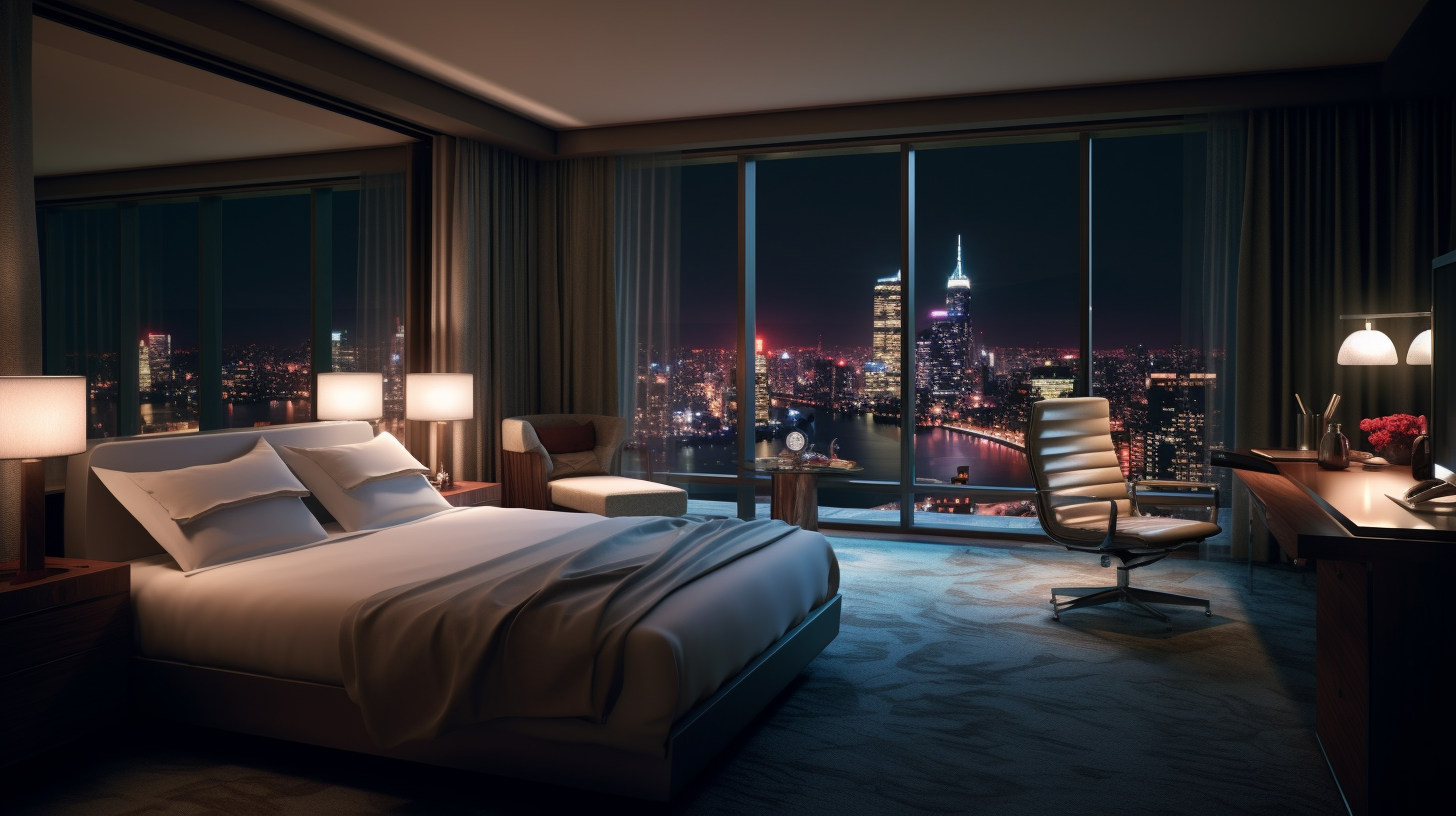Stepping into a Marriott hotel room, you might expect a sanctuary of silence, yet whispers and footsteps from the corridor often tell a different story.
This leads us to ask, “Are Marriott hotel rooms soundproof?” and the answer isn’t as straightforward as one might hope.
While the hotels excel at blocking out the city’s clamor, the internal soundproofing presents a puzzling contrast, often falling short of guest expectations.
Let’s dive into the acoustic reality of Marriott hotels, uncovering how guests can find their slice of quiet in the bustling world of travel hospitality.
The Soundproofing Paradox Within Marriott Hotels

Guests entering Marriott hotels are often greeted with a comforting hush that shields them from the bustling world outside.
The thick, soundproof glass in windows stands as a sentinel against the roar of city traffic and the blare of urban life.
This external silence, however, contrasts sharply with the soundscape within.
The very walls and ceilings, hollow and lacking in substantial sound barriers, become conduits for the array of noises that characterize hotel life—footsteps in the hallway, the jarring slam of a door, and the muffled but intrusive sounds of conversation from next door.
This dichotomy stems from a focus on mitigating external noise while the internal architecture—walls with minimal sound insulation, ceilings that carry sound from above, and doors with gaps—allows sound to travel with ease.
Guests seeking respite within their rooms may find themselves keenly aware of the comings and goings outside their doors, a reminder that their private haven is but a thin barrier away from the communal spaces of the hotel.
The Anatomy of Sound Transmission in Marriott Hotels
The construction choices in Marriott hotels reveal a preference for aesthetics and cost-efficiency over acoustic privacy.
The walls, often just drywall attached to wall studs, lack the density and absorbent materials necessary to dampen the symphony of human activity.
Ceilings, too, do little to soften the overhead impact of footsteps, leaving guests to contend with the sensation of a shared space rather than a secluded one.
And doors, despite their solid appearance, betray the solitude of the room with perimeters that allow sound to seep through as easily as light through a curtain.
These structural choices are not without consequence. The hollow nature of Marriott’s internal architecture becomes a resonating chamber, where every footfall and conversation is amplified.
The result is a soundscape that is in stark contrast to the silence boasted by the thick glass panes looking out onto the world—soundproofing that serves to keep the city at bay while inadvertently turning the inside of the hotel into an echo chamber of daily life.
Marriott’s Internal Acoustic Experience

The challenge Marriott faces in insulating interior spaces is not unique to the brand, but it is particularly felt in environments where guests expect a certain standard of comfort and privacy.
The emphasis on aesthetic appeal and cost management in hotel design often leads to compromises in sound insulation.
Marriott’s use of hollow walls and the absence of sufficient acoustic materials means that sounds travel freely between rooms and corridors, diminishing the sense of personal space that is essential for a comfortable stay.
The corridors and communal areas, bustling with activity, can become sources of intrusive noise that resonates through these less-than-solid barriers.
Conversations, even when held at a reasonable volume, echo into guest rooms, while the clatter of housekeeping carts and the closing of doors can startle and disturb.
The acoustical privacy expected in a hotel room is compromised, leaving guests feeling less isolated from their neighbors and the hotel’s daily operations than they might prefer.
Doors and Gaps: The Overlooked Culprits
While the walls and ceilings bear much of the blame for internal noise issues, the role of doors and their accompanying gaps is equally critical.
The thresholds of Marriott hotel rooms, designed for easy access and functionality, often lack the necessary seals to block sound.
The space under the door, a mere sliver in appearance, acts as a channel for noise, allowing the sounds of the hotel to spill into the room.
Even the walls around the door frames, which are often not reinforced, can let noise from the corridor enter the room uninvited.
Marriott’s choice of doors, while meeting safety and design standards, falls short in providing an acoustic barrier.
The solid core doors, which could dampen the noise, are often not complemented with the acoustic seals that are essential for minimizing sound transmission.
This oversight means that the door, the most direct point of access to a room, is also a significant weak point in the hotel’s internal soundproofing efforts.
The Business Impact of Internal Noise on the Marriott Brand
The internal noise issues at Marriott hotels have a direct effect on guest satisfaction and, by extension, on brand perception.
A guest’s experience with noise can significantly influence their overall impression of their stay and their likelihood to return or recommend the hotel to others.
For a brand like Marriott, which prides itself on providing a superior guest experience, the presence of internal noise can be particularly damaging.
It undermines the very essence of hospitality—providing a home away from home—and can lead to negative reviews, which are far-reaching in the digital age.
Marriott’s reputation as a provider of comfortable and serene accommodations is crucial to its success.
The brand’s ability to command premium rates is contingent upon delivering on this promise.
When guests encounter issues such as hallway noise permeating their rooms, the perceived value diminishes, and with it, the justification for higher pricing.
The long-term financial implications of such experiences can be significant, as they may lead to a decline in guest loyalty and a tarnished brand reputation.
Guest Strategies For A Peaceful Stay At Marriott

For guests looking to secure a peaceful stay at a Marriott hotel, proactive measures can make all the difference.
Upon booking, it’s wise to request a room located in a quieter part of the hotel, such as away from elevators, ice machines, and high-traffic areas.
Guests should also inquire about the availability of rooms that have been specifically designed or renovated with soundproofing in mind.
Engaging with the hotel staff about concerns over noise can lead to valuable insights and room recommendations that may not be evident from the booking site.
Once checked in, a quick assessment of the room for potential noise issues can save a lot of discomfort down the line.
If the room is adjacent to a busy area or has a door with visible gaps, requesting a room change preemptively is a reasonable step.
This can help ensure that the room serves as a quiet refuge, rather than a source of stress.
Remedies For In-Room Noise Reduction
Even with the best preparations, guests may still encounter noise during their stay. In such cases, several remedies can help reduce the impact of sound.
First, making use of the “Do Not Disturb” sign can minimize interruptions from hotel staff. If door gaps are an issue, placing a towel at the base of the door can serve as a temporary measure to block noise.
Additionally, reporting noise disturbances to the front desk as soon as they arise allows hotel staff the opportunity to address the issue promptly, which may include offering a room change or other compensation.
For guests who frequently encounter noise issues when traveling, investing in a pair of high-quality noise-canceling headphones or a white noise machine can be beneficial.
These devices can mask disruptive sounds and create a personal ambiance that promotes relaxation and sleep.
Conclusion
Marriott’s pursuit of tranquility within its walls is as much about soundproofing as it is about guest comfort.
The contrast between external silence and internal noise underscores a commitment to enhancing the guest experience.
Marriott is tasked with ensuring the peaceful stays that guests expect, aligning its reputation for hospitality with the acoustic quality of its rooms.
Addressing the whispers of footsteps and murmurs from corridors, Marriott must continue to refine its soundproofing practices.
A peaceful stay is a cornerstone of the hospitality experience, one that guests remember and value.
As Marriott adapts, the focus on creating quiet, personal havens will be key to maintaining its place as a preferred destination for travelers.
In this ongoing journey, each improvement in sound insulation and each piece of guest feedback contributes to Marriott’s evolution.
The goal is clear: to offer rooms where quiet is not just a feature but a guarantee, allowing guests to find solace in the stillness of their private space.
